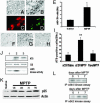Cyclin-dependent kinase 5 is a mediator of dopaminergic neuron loss in a mouse model of Parkinson's disease
- PMID: 14595022
- PMCID: PMC263868
- DOI: 10.1073/pnas.2232515100
Cyclin-dependent kinase 5 is a mediator of dopaminergic neuron loss in a mouse model of Parkinson's disease
Abstract
Recent evidence indicates that cyclin-dependent kinases (CDKs, cdks) may be inappropriately activated in several neurodegenerative conditions. Here, we report that cdk5 expression and activity are elevated after administration of 1-methyl-4-phenyl-1,2,3,6-tetrahydropyridine (MPTP), a toxin that damages the nigrostriatal dopaminergic pathway. Supporting the pathogenic significance of the cdk5 alterations are the findings that the general cdk inhibitor, flavopiridol, or expression of dominant-negative cdk5, and to a lesser extent dominant-negative cdk2, attenuates the loss of dopaminergic neurons caused by MPTP. In addition, CDK inhibition strategies attenuate MPTP-induced hypolocomotion and markers of striatal function independent of striatal dopamine. We propose that cdk5 is a key regulator in the degeneration of dopaminergic neurons in Parkinson's disease.
Figures




References
-
- Przedborski, S., Jackson-Lewis, V., Naini, A. B., Jakowec, M., Petzinger, G., Miller, R. & Akram, M. (2001) J. Neurochem. 76, 1265-1274. - PubMed
-
- Pines, J. (1993) Biochem. Soc. Trans. 21, 921-925. - PubMed
-
- Freeman, R. S., Estus, S. & Johnson, E. M., Jr. (1994) Neuron 12, 343-355. - PubMed
-
- Gao, C. Y. & Zelenka, P. S. (1995) Exp. Cell Res. 219, 612-618. - PubMed
-
- O'Hare, M. J., Hou, S. T., Morris, E. J., Cregan, S. P., Xu, Q., Slack, R. S. & Park, D. S. (2000) J. Biol. Chem. 275, 25358-25364. - PubMed
Publication types
MeSH terms
Substances
Grants and funding
LinkOut - more resources
Full Text Sources
Other Literature Sources
Medical

